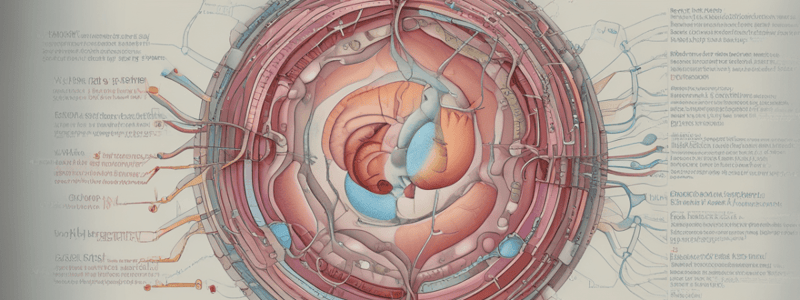Podcast
Questions and Answers
What is the function of the corpus luteum after ovulation?
What is the function of the corpus luteum after ovulation?
- To stimulate the release of FSH
- To stimulate the growth of another follicle
- To cause menstruation
- To produce estrogen and progesterone (correct)
What happens to the granulosa cells and theca interna after ovulation?
What happens to the granulosa cells and theca interna after ovulation?
- They degenerate and are replaced by fibroblasts
- They become smaller and produce estrogen
- They stop producing hormones and undergo apoptosis
- They increase in size and become specialized in producing progesterone and estrogen (correct)
What is the role of LH in the corpus luteum?
What is the role of LH in the corpus luteum?
- To stimulate the growth of follicles
- To cause the corpus luteum to degenerate
- To stimulate the production of FSH
- To promote the production of estrogen and progesterone (correct)
What happens to the corpus luteum if pregnancy does not occur?
What happens to the corpus luteum if pregnancy does not occur?
What is the role of hCG in the corpus luteum of pregnancy?
What is the role of hCG in the corpus luteum of pregnancy?
What is the corpus luteum of menstruation?
What is the corpus luteum of menstruation?
What happens to the corpus luteum of pregnancy after 4-5 months?
What happens to the corpus luteum of pregnancy after 4-5 months?
What is corpus albicans?
What is corpus albicans?
What stimulates the release of follicle-stimulating hormone (FSH) from the pituitary gland?
What stimulates the release of follicle-stimulating hormone (FSH) from the pituitary gland?
What is the effect of estrogen on the release of GnRH and LH?
What is the effect of estrogen on the release of GnRH and LH?
What is the function of inhibin in the menstrual cycle?
What is the function of inhibin in the menstrual cycle?
What happens to the oocyte after the LH surge?
What happens to the oocyte after the LH surge?
What is the fate of the corpus luteum in the absence of pregnancy?
What is the fate of the corpus luteum in the absence of pregnancy?
What is the effect of the decrease in progesterone on the uterus?
What is the effect of the decrease in progesterone on the uterus?
What is the result of the decrease in estrogen levels after menstruation?
What is the result of the decrease in estrogen levels after menstruation?
What is the fate of the regressing corpus luteum?
What is the fate of the regressing corpus luteum?
Flashcards are hidden until you start studying
Study Notes
Corpus Luteum Formation
- After ovulation, granulosa cells and theca interna form a temporary endocrine gland called corpus luteum.
- Corpus luteum is influenced by LH, which causes granulosa cells to increase in size and become granulosa lutein cells, while theca interna cells become smaller theca lutein cells.
Hormone Production
- Under LH influence, granulosa lutein cells and theca lutein cells produce estrogen and progesterone for 10-12 days.
- If pregnancy does not occur, hormone production stops, and LH levels decrease, leading to apoptosis of the cells.
Menstrual Cycle
- The decrease in hormone production leads to menstruation.
- FSH secretion increases, and the growth of a new group of follicles begins, starting the next menstrual cycle.
- The corpus luteum that lasts only one menstrual cycle is called the corpus luteum of menstruation.
Corpus Luteum Regression
- After the corpus luteum degenerates, remnants are phagocytosed by macrophages, and fibroblasts invade the area, producing a scar called corpus albicans.
Pregnancy
- If pregnancy occurs, the hormone hCG is produced by the trophoblast cells of the implanted embryo, maintaining progesterone levels.
- The corpus luteum of pregnancy grows larger over time and is maintained by hCG for 4-5 months.
- Eventually, the placenta takes over progesterone production, and the corpus luteum of pregnancy is replaced by corpus albicans.
Follicular Development and Hormonal Regulation
- Follicular development depends on follicle-stimulating hormone (FSH) from the pituitary gland, which is stimulated by gonadotropin-releasing hormone (GnRH) from the hypothalamus.
- The dominant follicle secretes estrogen, which increases the release of GnRH and leads to a surge in luteinizing hormone (LH) from the pituitary gland.
Hormonal Mechanisms
- Inhibin, a hormone produced by granulosa and luteal cells, reinforces the negative feedback of estrogen and progesterone on the hypothalamus and anterior pituitary.
- Estrogen and progesterone have a negative feedback mechanism on the hypothalamus and anterior pituitary.
Ovulation and Oocyte Release
- The LH surge causes meiosis I to be completed, resulting in a primary oocyte and first polar body.
- Granulosa cells are stimulated to produce more follicular fluid, and the ovarian wall weakens.
- Smooth muscle contractions begin in the theca externa, leading to increased pressure and wall weakening, causing the follicle to rupture at the stigma.
- The oocyte, along with its surrounding corona radiata and follicular fluid, is expelled and adheres loosely to the ovary surface.
- The oocyte must be fertilized within about 24 hours or it begins to degenerate.
Hormonal Function and Fate of the Corpus Luteum
- In the absence of pregnancy, the corpus luteum secretes progesterone for 10-12 days after ovulation due to the LH surge.
- Without further LH stimulation, the corpus luteum cells stop producing steroids and undergo apoptosis.
- The decrease in progesterone leads to menstruation, the shedding of the uterine mucosa.
- Lowered estrogen levels lead to increased FSH secretion, stimulating new follicle growth and starting the next menstrual cycle.
- The regressing corpus luteum is phagocytosed by macrophages and replaced by a scar of dense connective tissue, the corpus albicans.
Studying That Suits You
Use AI to generate personalized quizzes and flashcards to suit your learning preferences.




